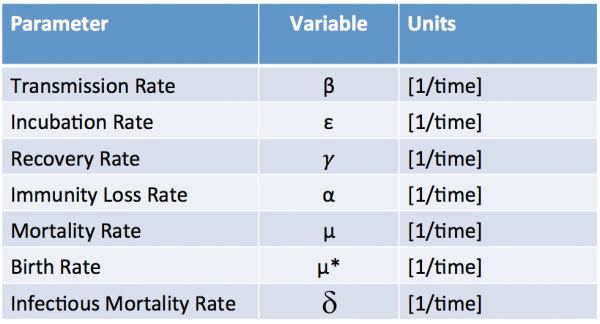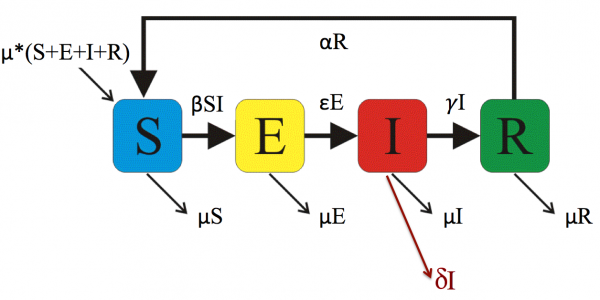Notice: this Wiki will be going read only early in 2024 and edits will no longer be possible. Please see: https://gitlab.eclipse.org/eclipsefdn/helpdesk/-/wikis/Wiki-shutdown-plan for the plan.
Difference between revisions of "Epidemiological Parameters"
(→What they mean) |
(→What they mean) |
||
| Line 12: | Line 12: | ||
The table below shows the epidemiological parameters for the SEIR model shown above. Note that the UNITS or all or the parameters are ''inverse time.'' | The table below shows the epidemiological parameters for the SEIR model shown above. Note that the UNITS or all or the parameters are ''inverse time.'' | ||
| − | [[Image:EpiParamsTable.png|600px]] | + | [[Image:EpiParamsTable.png|600px]] Figure 1: SEIR Compartment Model |
| − | Each of the parameters are rate constants, but the transmission rate &beta has a special role in that it appears inside | + | Each of the parameters are rate constants, but the transmission rate &beta has a special role in that it appears inside the ''mass action term.'' This interaction term has the product SI. |
| + | |||
| + | If the compartments are all normalize so that the total population S+E+I+R = 1 | ||
| + | then Susceptible individuals become exposed at a rate, &beta SI | ||
| + | For S+E+I+R = P, we have | ||
[[Image:InterProduct.gif]] | [[Image:InterProduct.gif]] | ||
== 3 == | == 3 == | ||
Revision as of 14:50, 9 April 2015
About Epidemiological Parameters
Common Variables and their Units
Using an SEIR model as an example lets discuss some common epidemiological parameters and what they mean. The figure shows the compartments for S=Susceptible, E=Exposed (but not yet infectious), I=Infectious (Shedding Virus), R=Recovered. The arrows show the transitions or people moving between the compartments in a specified time interval. See the page on compartment models.
What they mean
The table below shows the epidemiological parameters for the SEIR model shown above. Note that the UNITS or all or the parameters are inverse time.
 Figure 1: SEIR Compartment Model
Figure 1: SEIR Compartment Model
Each of the parameters are rate constants, but the transmission rate &beta has a special role in that it appears inside the mass action term. This interaction term has the product SI.
If the compartments are all normalize so that the total population S+E+I+R = 1 then Susceptible individuals become exposed at a rate, &beta SI For S+E+I+R = P, we have


